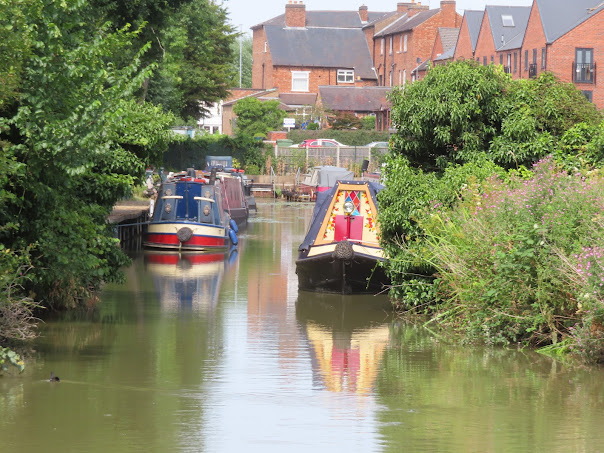A good night's sleep was had and despite some spitty rain it was all dry by the time we left
There were banks of rosebay willowherb on the banks, just starting to go over to seed, like cotton wool. We called it fireweed as it was said to be the first thing to grow on bombsites, and apparently that is the North American name as it is the first on the burned out remains after a forest fire. Apparently the leaves can be used to make a tea. That would save a few quid, and could be a new cottage industry.
We were close to Hartshill and as no one was there we stopped to top up with water before heading off again.
This stretch of canal must have been a hive of industry with loads of narrow boats waiting, loaded and leaving the numerous wharves for the road stone quarries here. The overhead gantries took the product across the canal to road and rail loading points at the later stages of the industry. The quarry above the quarry is a massive hole and well worth a walk up on a nice day.
There were several boats moored along the outskirts Nuneaton which is nice to see. It ids another of those places that Chinese whispers have put everyone off from mooring. We have stopped in the past and we lived to tell the tale too. Out the other side there is this ma'o'hsive warehouse but there was no sign of another of my favourite tree? On the towpath side there is another big estate of house being built. With the current discussion about house building am I alone in thinking that every house that is currently being built, as we are told there are so few, must be being constructed on the side of one canal or another as where ever you go there are new houses going up!
We were soon at Marston Junction and this time we had a window of opportunity to make a flying visit. No hindrance to our turn into this very nondescript junction. I always think junctions should have to be painted white as a bit of a show. However in these times C&RT would .never get round to repainting it, or I suppose delete the graffiti
I stopped in the narrows under the bridge and got shoulder deep down the weed hatch as I suspected something would be found. Nothing was and I was ready for the off again when a boat appeared heading for the junction. Just after the narrows there was this show of wild flowers. Is it just me or have the wildflowers being particularly profuse this year. They make a great show none the less.
Most of the fields around here haven't been harvested yet, where other places we have passed are cut and baled already. Does that mean that this is spring wheat rather than winter wheat? Or are they just hoping for better quality or quantity with a good dose of sun on it?
The bridges on the Ashby Canal seem to remind me a little of those on the Macclesfield Canal, without the turnover bridges. The canal was opened in 1804.
On the southern outskirts of Hinkley is this arm that was once Hinkley Wharf. In October 1805 there was an auction of two closes of land at the George Inn in Hinkley. The cut from the canal needed to be built.
On the north west of Hinkley is the Triumph factory. The original Triumph Engineering company called in receivers in 1983. A John Bloor bought the name and the rights and set about making a new product and company. By 1988 this factory had been constructed on a 10 acre site and by 2017 2,000 were employed and they sold 63,400 motorbikes in 2017!
Another bridge and reflection showing how little wind there has been.
As we approached Stoke Golding Wharf I spotted this boundary marker. MR stands for Midland Railway who bought the Ashby Canal in 1846. However a railway did not really challenge the canal for another 30 years and then there was a steady decline in tonnage carried on the canal and even less after there was major subsidence on the northern section caused by mining and that section of canal was closed in 1944.
We moored up after the wharf and then went for a walk into the village for a few bits and a pint. On Station Road we passed this building that was once a hoisery factory. It was opened in 1892 by 'Honest' John Hall who had been making nice warm socks for the farming community since around 1845. The factory then employed 16 people but trade increased until in 1977 the company outgrew this place and a much larger new place was constructed in Hinkley. H.J. Hall is still going strong and making specialist socks as well as 'normal' and you can buy them direct too.
The canal was noticeably much shallower after Hinkley and like all canals needs a fair clipping on the offside to assist sight lines as you can't stray too far off the centre line.













No comments:
Post a Comment